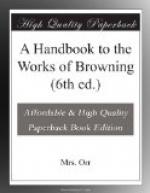ROMANTIC POEMS.
The prevalence of thought in Mr. Browning’s poetry has created in many minds an impression that he is more a thinker than a poet: that his poems not only are each inspired by some leading idea, but have grown up in subservience to it; and those who hold this view both do him injustice as a poet, and underrate, however unconsciously, the intellectual value of what his work conveys. For in a poet’s imagination, the thought and the thing—the idea and its image—grow up at the same time; each being a different aspect of the other.[86] He sees, therefore, the truths of Nature, as Nature herself gives them; while the thinker, who conceives an idea first, and finds an illustration for it afterwards, gives truth only as it presents itself to the human mind—in a more definite, but much narrower form. Mr. Browning often treats his subject as a pure thinker might, but he has always conceived it as a poet; he has always seen in one flash, everything, whether moral or physical, visible or invisible, which the given situation could contain.[87] This fact may be recognized in many of the smaller poems, which, for that reason, I shall find it impossible to class; but it is best displayed in a couple of longer ones, which I have placed under the head “Romantic.” They are distinct from the majority of the “Dramatic Romances,” although included in them. For with these the word “romantic” denotes an imaginary experience, which may be frankly supernatural, as in “The Boy and the Angel;” or only improbable, as in “Mesmerism;” or semi-historical and local, as in “In a Gondola;” or simply human, and possible anywhere and anywhen, as in “The Last Ride Together;” or in “Dis aliter Visum,” and “James Lee’s Wife,” which might be classed with them. I am now using it to mark certain cases, in which the author’s imagination has not brought itself to the test of any consistent experience, but simply presents us with certain groups of material and mental—of real and ideal possibilities, which we may each interpret for ourselves. They occur in
“Childe Roland
to the Dark Tower Came.” ("Dramatic Romances.”
Published in “Men
and Women.” 1855.)
“The Flight of
the Duchess.” ("Dramatic Romances.”
Published
in “Dramatic Romances
and Lyrics.” 1845.)[88]
The first of these has been taken by some intelligent critics to be a moralizing allegory; the second, a moralizing fairy-tale. They are, therefore, a useful type both of Mr. Browning’s poetic genius, and of the misunderstanding, to which its constantly intellectual employment has exposed him.




